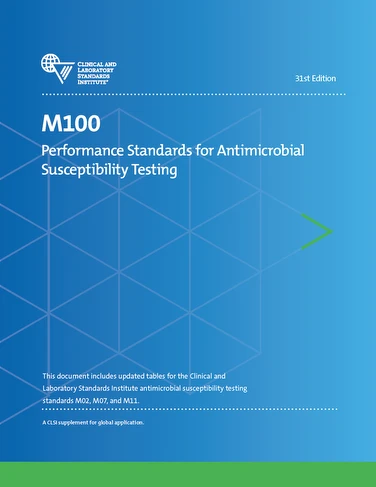You'll receive the latest updates on new standards, guidelines, and educational resources, as well as expert insights to help enhance your laboratory's performance and compliance.
CLSI Publishes M100—Performance Standards for Antimicrobial Susceptibility Testing, 31st Edition

Malvern, Pennsylvania, USA—The Clinical and Laboratory Standards Institute (CLSI) has published CLSI M100—Performance Standards for Antimicrobial Susceptibility Testing, 31st Edition.
The tables presented in CLSI M100 represent the most current information for drug selection, interpretation, and quality control using the procedures standardized in CLSI M02, M07, and M11. Users should replace previously published tables with these new tables.
Melvin P. Weinstein, MD, Chairholder of CLSI M100 and Co-Director, Microbiology Laboratory, Robert Wood Johnson University Hospital, said, “As an infectious diseases physician and clinical microbiology lab director, I always look forward to each year’s updated edition of CLSI M100. Our lab adheres to the CLSI recommended antibiotic susceptibility breakpoints, and each new edition of CLSI M100 helps us provide the best of care for our patients with bacterial infections.”
James Lewis, PharmD, FIDSA, Vice-Chairholder of M100 and ID Clinical Pharmacy Supervisor, Oregon Health and Science University, observed, “Every year I look forward to the release of the new CLSI M100. It is an annual reminder of the importance of clinical microbiology in the care of our patients and how constantly changing bacteria represent a challenge to our ability to optimize patient care. The updated CLSI M100 from CLSI integrates new data, new agents, and up-to-date information to help optimize the care of our patients.”
M100 is also available as part of a package with either CLSI M02—Performance Standards for Antimicrobial Disk Susceptibility, 13th Ed., or CLSI M07— Methods for Dilution Antimicrobial Susceptibility Tests for Bacteria That Grow Aerobically, 11th Ed. A package that includes CLSI M100, M02, and M07 is also available.
CLSI’s Annual Updates Webinar, moderated by Janet Hindler, MCLS, MT(ASCP), F(AAM), Los Angeles Department of Public Health and presented by Romney M. Humphries, PhD, D(ABMM) of Vanderbilt University and Audrey Schuetz, MD, MPH, D(ABMM) of the Mayo Clinic, helps users identify the major changes found in the updated edition of CLSI M100. Participants will learn to design a strategy for implementing the new standard into laboratory practices and get communication strategies for informing clinical staff of significant AST and reporting changes. The webinar will take place twice, on Wednesday, April 28, and Thursday, April 29, and will cover the same information.
Dr. Schuetz said, “I’m thrilled to see the new material in recently published CLSI M100! Highlights include an easy and inexpensive method for rapid direct blood culture AST by disk diffusion, new breakpoints for imipenem-relebactam (another option for multidrug resistant GNRs), a totally new class of antimicrobial (lefamulin) with breakpoints against some organisms causing community-acquired pneumonia, tedizolid predicted by linezolid MIC for certain gram-positive organisms, revised oxacillin breakpoints for some staphylococci, and finally, taxonomic updates on the species within S. aureus complex.”
For more information about the new edition of CLSI M100 or the AST Annual Update Webinar, contact CustomerService@clsi.org +1.610.688.0100.
CLSI sets the standard for quality in medical laboratory testing. A not-for-profit membership organization, CLSI brings together the global laboratory community for the advancement of a common cause: to foster excellence in laboratory medicine.
For over 50 years, our members, volunteers, and customers have made CLSI a respected, transformative leader in the development and implementation of medical laboratory testing standards. Through our unified efforts, we will continue to set and uphold the standards that drive quality test results, enhance patient care delivery, and improve health care around the world.
By using CLSI standards, laboratorians can improve process quality, speed the development of standard operating procedures, and implement safer practices with greater ease and efficiency.